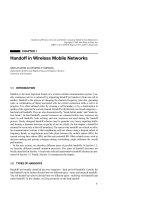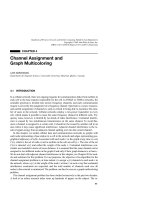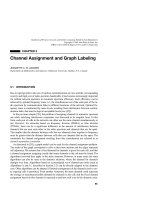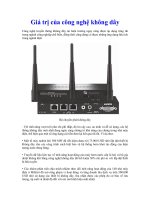Tài liệu Sổ tay của các mạng không dây và điện toán di động P14 ppt
Bạn đang xem bản rút gọn của tài liệu. Xem và tải ngay bản đầy đủ của tài liệu tại đây (86.66 KB, 15 trang )
CHAPTER 14
Security and Fraud Detection in
Mobile and Wireless Networks
AZZEDINE BOUKERCHE
Department of Computer Sciences, University of North Texas
14.1 INTRODUCTION
The fusion of computer and telecommunication technologies has heralded the age of in-
formation superhighway over wireline and wireless networks. Mobile cellular communi-
cation systems and wireless networking technologies are growing at an ever-faster rate,
and this is likely to continue in the foreseeable future. Wireless technology is presently be-
ing used to link portable computer equipment to corporate distributed computing and oth-
er sources of necessary information. Wide-area cellular systems and wireless LANs
promise to make integrated networks a reality and provide fully distributed and ubiquitous
mobile communications, thus bringing an end to the tyranny of geography. Higher relia-
bility, better coverage and services, higher capacity, mobility management, power and
complexity for channel acquisition, handover decisions, security management, and wire-
less multimedia are all parts of the potpourri.
Further increases in network security are necessary before the promise of mobile
telecommunication can be fulfilled. Safety and security management against fraud, intru-
sions, and cloned mobile phones, just to mention a few, will be one of the major issues in the
next wireless and mobile generations. A “safe” system provides protection against errors of
trusted users, whereas a “secure” system protects against errors introduced by impostors
and untrusted users [1]. Therefore, rather than ignoring the security concerns of potential
users, merchants, and telecommunication companies need to acknowledge these concerns
and deal with them in a straightforward manner. Indeed, in order to convince the public to
use mobile and wireless technology in the next and future generations of wireless systems,
telecom companies and all organizations will need to explain how they have addressed the
security of their mobile/wireless systems. Manufacturers, M-business, service providers,
and entrepreneurs who can visualize this monumental change and effectively leverage their
experiences on both wireless and Internet will stand to benefit from it.
Concerns about network security in general (mobile and wired) are growing, and so is
research to match these growing concerns. Indeed, since the seminal work by D. Denning
[9] in 1981, many intrusion-detection prototypes, for instance, have been created. Intru-
sion-detection systems aim at detecting attacks against computer systems and wired net-
309
Handbook of Wireless Networks and Mobile Computing, Edited by Ivan Stojmenovic´
Copyright © 2002 John Wiley & Sons, Inc.
ISBNs: 0-471-41902-8 (Paper); 0-471-22456-1 (Electronic)
works, or against information systems in general. However, intrusion detection in mobile
telecommunication networks has received very little attention. It is our belief that this is-
sue will play a major role in future generations of wireless systems. Several telecom carri-
ers are already complaining about the loss due to impostors and malicious intruders.
In this chapter, we will identify and describe several aspects of wireless and mobile net-
work security. We will discuss the intrusion detection systems in wired and wireless net-
works and identify the new challenges and opportunities posed by the ad hoc network, a
new wireless paradigm for mobile hosts. Unlike traditional mobile wireless networks, ad
hoc networks do not rely on any fixed infrastructure. Instead, they rely on each other to keep
the network connected. Next, we will examine the authentication problem of mobile users.
Finally, we discuss the problems of cloning and fraud detection in mobile phone operations
14.2 NETWORK SECURITY PROBLEMS
Security is an essential part of wired and wireless network communications. Interestingly
enough, these systems are designed to provide open access across vast networked environ-
ments. Today’s technologies are usually network-operation-intrusive, i.e., they often limit
the connectivity and inhibit easier access to data and services. With the increasing popu-
larity of wireless networks, the security issue for mobile users could be even more serious
than we expect. The traditional analogue cellular phones are very insecure. The 32-bit ser-
ial number, the 34-bit phone number, and the conversation in a cell can be scanned easily
by an all-band receiver. The widely used advanced mobile phone system (AMPS) is an
analogue phone system. Therefore, sending a password or a host name through this system
can be a serious security issue. Other security issues in wireless networks that have been
studied extensively are anonymity and location privacy in mobile networks; these have re-
ceived a great deal of interest recently [23]. A typical situation is one in which a mobile
user registered in a certain home domain requests services while visiting a foreign do-
main. Concerned about security and privacy, the user would prefer to remain anonymous
with respect to the foreign domain. That is, only the home domain authority should be in-
formed as to the mobile user’s real identity, itinerary, whereabouts, etc. Another important
issue, namely cloning phones, raises a number of concerns to many telecom carriers. In-
deed, many telecommunication companies are losing money due to the use of clones or
genuine mobile phones by impostors. One might argue that although it is rather easy to
clone an AMPS phone, it is much trickier to clone a D-AMPS, a GSM, or an IS-95 phone.
However, the security issue remains, and needs to be resolved in the next wireless network
generation. Consequently, there has been a great deal of interest recently in designing mo-
bile phones using new technologies, such as Boot Block flash technology used by Intel
Corporation, that will make it much more difficult to clone cellular phones. However, to
the best of our knowledge there is very little work being done at the software level. To
combat cloning, cellular operators analyze usage to check for unusual patterns. Most obvi-
ously, they know that genuine phone cannot be in two places at once. If a phone is making
more than one call at a time, it has definitely been cloned. Furthermore, to verify if a call
is out of the client patterns, current software (i) does not have an efficient automatic
process to warn clients about the impostors using their mobile phones; in most of these
310
SECURITY AND FRAUD DETECTION IN MOBILE AND WIRELESS NETWORKS
systems, human staff are used to do that (only lists of large bills are reviewed to identify
cloned phones); (ii) has no efficient ways to control/identify impostors; and (iii) uses an
“experimental satisfaction” to prove the correctness of the security framework. Some sys-
tems provide the billing process via the Web. However, the identification of a cloned
phone is done only at the end of the month. This, unfortunately, is not quite efficient and
may lead to a big loss of revenue for the carrier.
The wireless Web opens up many new business opportunities, the most important of
which use location-based technology. Ever since the mobile Internet was first suggested,
antivirus companies have warned that viruses could attack cellular phones and PDSs. Tim-
ofonica was among the first viruses that attacked cell phones. Timofonica was an ordinary
virus programmed to send abusive messages to random users of Spanish Telefonica mo-
bile systems. Viruses are a threat to any computing platform and may be a threat to wire-
less terminals that include processing and memory akin to those of modern computers.
14.3 NETWORK SECURITY MANAGEMENT PLAN
An adequate security system management policy has long been an important issue. A
comprehensive network security plan must also consider losses of privacy when we define
authentication and authorization as well as losses of performance when we define key
management and security protocols. Therefore, a security plan must encompass all of the
elements that make up the wireless and/or wired network, and provide important services
such as:
1. Access control, i.e., authorization by capability list, wrappers, and firewalls (access
control matrix)
2. Confidentiality, i.e., we must ensure that information and transmitted messages are
accessible only for reading by authorized parties
3. Authentication, i.e., the receiver must be able to confirm that the message is indeed
from the right sender
4. Nonrepudiation, i.e., the sender cannot deny that the message was indeed sent by
him/her
5. Integrity, i.e., the message has not been modified in transit
6. Availability, i.e., making sure that the system is available to authorized parties when
needed
7. Security administration, i.e., checking audit trails, encryption and password man-
agement, maintenance of security equipment and services, and informing users of
their responsibilities.
14.4 INTRUSION DETECTION SYSTEMS (IDS)
Intrusion is most probably one of the key issues that wireless and mobile systems will
have to deal with. The nature of wireless ad hoc networks makes them very vulnerable to
14.4 INTRUSION DETECTION SYSTEMS (IDS)
311
an adversary’s malicious attacks. Generally speaking, an intrusion can be defined as an act
of a person or proxy attempting to break into or misuse your system in violation of an es-
tablished policy. Very little research work dealing with the intrusion problem has been
done for wireless networks.
In this section, we shall describe the intrusion problem in general. We hope that re-
searchers will pick up what has been done in related areas, and find efficient approaches
on how to deal with this problem in an ad hoc network environment.
14.4.1 Current IDS Techniques
Generally speaking, intrusion can be classified as: (i) misuse intrusions, i.e., well-defined
attacks against known system vulnerabilities; and (ii) anomaly intrusions, i.e., activities
based on deviation from normal system usage patterns. Intrusion detection systems (IDS)
are one of the latest security tools in the battle against these attacks. As is well known, it is
very difficult to determine exactly which activities provide the best indicators for the es-
tablished (normal) usage patterns. Thus, researchers have turned to using expert systems
or knowledge-based intrusion detection to search for activities known to be indicative of
possible intrusive behavior [16]. The motivation behind this approach is to seek a proper
behavior as opposed to a normal one. Knowledge-based intrusion detection schemes apply
the knowledge they have accumulated about specific attacks and system vulnerabilities.
Using this knowledge database, any action that is not explicitly recognized as an attack is
considered acceptable. Otherwise, an alarm is triggered by the system.
There are many different intrusion systems available in the marketplace. Expert sys-
tems are based on knowledge-based intrusion detection techniques. Each attack is identi-
fied by a set of rules. Rule-based languages [13] are used for modeling the knowledge that
experts have accumulated about attacks/frauds. Information regarding some intruders has
also been added to these systems. A major drawback of knowledge-based intrusion sys-
tems is the difficulty of gathering the information on the known attacks (which should be
updated regularly) and developing a comprehensive set of rules that can be used to identi-
fy intrusive behaviors. Some systems use a combination of several approaches to cover
both the normal and proper behavior schemes [17]. We refer to them as behavior-based in-
trusion detection. Their basic characteristic is that any action that does not match with a
previously learned behavior triggers an alarm. The action is considered as intrusive. The
main advantages of these systems are that they can exploit new and unforeseen attacks,
and contribute to automatically discovering new attacks. However, their high false alarm
rate is generally cited as a main drawback of these systems, due basically to the accuracy
of the behavior information accumulated during the learning process.
14.5 SECURING DATA TRANSFER IN DIGITAL MOBILE SYSTEMS
All digital mobile systems provide security through some kind of encryption. Data can be
encrypted in many ways, but algorithms used for secure data transfer fall into two cate-
gories: symmetric and asymmetric. Both rely on performing mathematical operations us-
ing a secret number known as a key. The difficulty with symmetric algorithms is that both
312
SECURITY AND FRAUD DETECTION IN MOBILE AND WIRELESS NETWORKS
parties need to have a copy of the key. On the other hand, asymmetric techniques use two
separate keys for encryption and decryption. Usually, the encryption key can be publicly
distributed, whereas the decryption key is held securely by the recipient.
The most widely used symmetric algorithm in DES (data encryption standard), devel-
oped by IBM in 1977. It uses a 56-bit key, which seemed unbreakable at that time. In
1997, a group of Internet users managed to read a DES-coded message. Most organization
now use triple-DES, which uses 112 bits. The basic idea is that larger keys mean more
possible permutations, and so better encryption. GMS encrypts all data between the phone
and the base station using a code called A5 (The A stands for algorithm). The details of the
code are kept secret to make it harder to crack. Unfortunately, details have been leaked out
over the years and have been posted on hackers’ web sites. Thus, we believe there is still
much work to be done in the cloning mobile phone area.
Several different asymmetric algorithms have been developed, each using a different
type of “one-way” mathematical function. Rivest et al. [32] proposed an efficient algo-
rithm, which they refer to as RSA, that relies on the fact that factorization is more difficult
than multiplication. Indeed, multiplying two prime numbers together is easy for a comput-
er, but recovering those two numbers from the product is not. The main drawback of
asymmetric schemes is that they use a lot of CPU, and so cannot be used to encrypt an en-
tire message through a mobile phone. Instead, A5 encrypts the message itself using a sym-
metric algorithm, with a key randomly generated by the network and sent to the handset
using an asymmetric algorithm.
14.6 SECURING WIRELESS AD HOC NETWORKS
Many WLANs in use today need an infrastructure network. Infrastructure networks not
only provide access to other networks, but also include forwarding functions, medium ac-
cess control, etc. In these infrastructure-based wireless networks, communication typical-
ly takes place only between the wireless nodes and the access point, but not directly be-
tween the wireless nodes. Ad hoc wireless networks, however, do not need any
infrastructure to work. Each node can communicate with another node; no access point
controlling medium access is necessary. Mobile nodes within each other’s radio range
communicate directly via wireless links, whereas those that are far apart rely on other
nodes to relay messages as routers. Node mobility in an ad hoc network causes frequent
changes of the network topology.
Since an ad hoc network can be deployed rapidly at relatively low cost, it becomes an
attractive option for commercial uses such as sensor networks or virtual classrooms. How-
ever, before an ad hoc network becomes a commodity, several security issues must first be
resolved. On one hand, the security-sensitive applications of ad hoc networks require a
high degree of security; on the other hand, ad hoc networks are inherently vulnerable to
security attacks. Therefore, security mechanisms are indispensable for ad hoc networks.
As in any wireless or wired network, traffic across an ad hoc network can be highly
vulnerable to security threats. Thus, to secure an ad hoc network, one should consider not
only the attributes described in Section 14.3, i.e., availability, confidentiality, integrity, au-
thentication, and nonrepudiation. but also new types of threats that are extended even to
14.6 SECURING WIRELESS AD HOC NETWORKS
313
the basic structure of the networks. The salient characteristics of ad hoc networks pose
both challenges and opportunities in achieving these security goals.
Since ad hoc networks use wireless links, they are susceptible to link attacks ranging
from passive eavesdropping to active impersonation, message replay, and message distor-
tion. Active attacks might allow the adversary to delete messages, inject erroneous, modi-
fy messages, and impersonate a node, thereby violating availability, integrity, authentica-
tion, and nonrepudiation.
14.6.1 Intrusion Detection in Wireless Ad Hoc Networks
Most of the IDS systems developed for wired networks described in previous section can-
not be applied to wireless networks. This is mainly due to the fact that today’s network-
based IDSs, which rely on real-time traffic analysis, can no longer function in the wireless
and mobile environments such wireless ad hoc networks. When compared with wired net-
works, in which traffic monitoring is usually done at switches, routers, and gateways, a
wireless ad hoc network does not have traffic concentration points at which IDS can col-
lect audit data for the entire network. Recall that in a wireless ad hoc network, each node
can communicate with another node, and no access point controlling medium access is
necessary. Mobile nodes within each other’s radio range communicate directly via wire-
less links, whereas those that are far apart rely on other nodes to relay messages as routers.
Recently, Zhang and Lee [31] examined the vulnerability of a wireless ad hoc network.
They described an intrusion detection and response mechanism. In their approach, each
node is responsible for detecting signs for intrusion locally and independently, but neigh-
boring nodes can collaboratively investigate in a broader range. Individual IDS agents are
placed on each and every node. Each IDS agent runs independently and monitors local ac-
tivities such as user/system activities, communication activities, etc. These IDS agents
collectively form the IDS system to protect the wireless ad hoc network against malicious
attacks. If an IDS agent detects an intrusion from local data, neighboring IDS agents will
collaborate in the global intrusion detection actions. Intrusion detection responses are pro-
vided by both the local response initiated by the IDS agent, and global response modules.
The type of intrusion response depends on the type of network protocols and applications,
and confidence (or certainty) in evidence. For example, the IDS agent can send a “reau-
thentication” request to all nodes in the network to prompt the end users to authenticate
themselves (end hence their wireless nodes), using out-of-bound mechanisms (e,g., visual
contacts). Only the reauthenticated nodes may collectively negotiate new communication
channels, which in turn recognize each other as legitimate. Thus, the compromised and/or
malicious nodes can be excluded. Last but not least, the authors use a secure communica-
tion module in their IDS system and provide a high-confidence communication channel
among IDS agents. However, this work is still at an early stage, and no experimental data
were provided to study the effectiveness of their scheme.
14.6.2 Securing Routing Protocol in Wireless Ad Hoc Networks
Security for any routing protocol [24, 29] is a very difficult problem to deal with. One can
take advantage of the redundancies in the network topology, i.e., multiple routes between
314
SECURITY AND FRAUD DETECTION IN MOBILE AND WIRELESS NETWORKS









